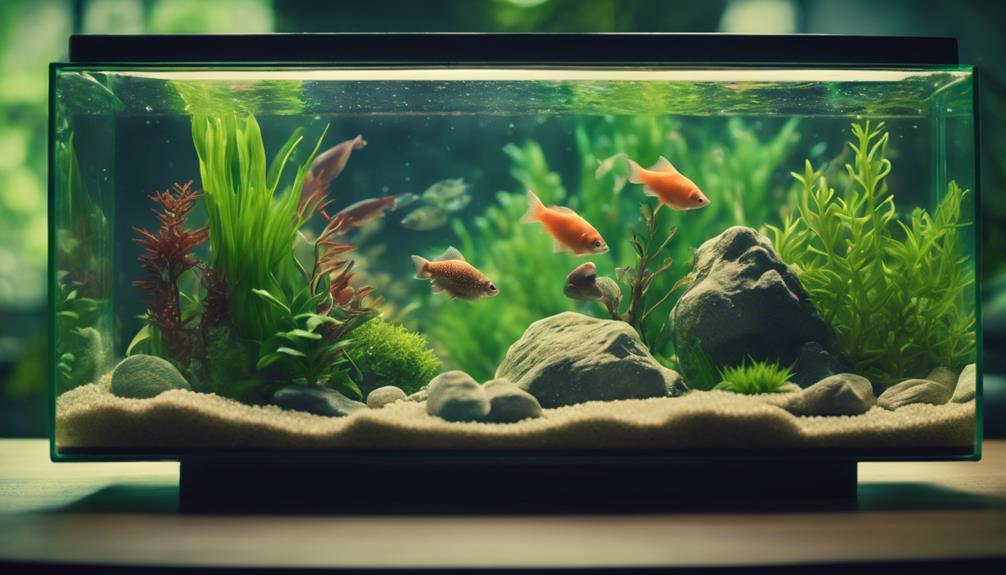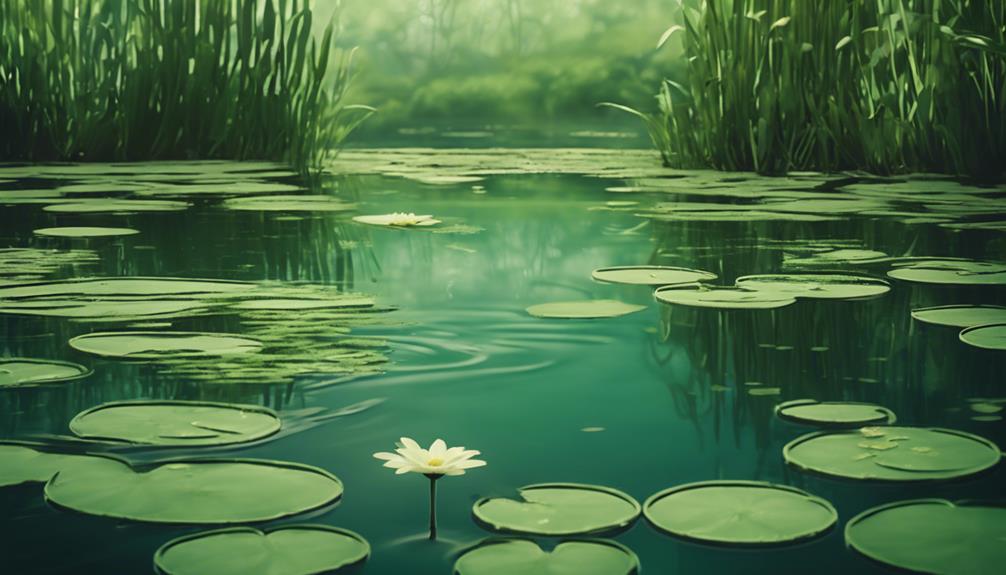You can effectively prevent and control algae growth in your aquarium by addressing the root causes of this common problem: excess nutrients, lack of natural algae control, and an unoptimized aquarium environment. To balance nutrient levels naturally, maintain nitrate and phosphate levels below 10 ppm and 0.5 ppm, respectively, and use live plants to absorb excess nutrients. Harness the power of algae eaters like Plecostomus and Nerite Snail to feed on algae. Optimize your aquarium environment by limiting direct sunlight, performing regular water changes, and maintaining good water circulation. By tackling these areas, you'll be well on your way to a balanced, algae-free ecosystem – and there's more to explore to guarantee long-term success.
Table of Contents
Key Takeaways
- Maintain nitrate levels below 10 ppm and phosphate levels below 0.5 ppm to prevent algae growth and excess nutrient buildup.
- Introduce algae-eating species like Plecostomus, Mystery Snail, and Caridina Shrimp to control algae growth and maintain a healthy ecosystem.
- Optimize aquarium environment by limiting direct sunlight, replacing fluorescent lamps regularly, and maintaining good water circulation and oxygen levels.
- Use live plants like hornwort and wisteria to absorb excess nutrients, starving out algae and preventing growth.
- Perform regular water changes to reduce the risk of algae growth and maintain a balanced nitrogen cycle.
Balance Nutrient Levels Naturally
To prevent algae growth, you need to maintain a delicate balance of nutrient levels in your aquarium, keeping nitrate levels below 10 ppm and phosphate levels below 0.5 ppm.
This delicate balance is vital, as excess nutrients can fuel algae growth.
One effective way to reduce nutrient levels is by incorporating live plants into your aquarium. These aquatic plants absorb nitrogen and phosphorus, starving out algae and preventing growth.
Fast-growing stem plants like hornwort and wisteria are particularly effective at using up excess nutrients.
Additionally, regular water changes are essential for maintaining a healthy aquarium environment and preventing excessive nutrient build-up. By doing so, you'll reduce the risk of algae growth and maintain a balanced nitrogen cycle.
Harness Power of Algae Eaters
By introducing algae-eating species to your aquarium, you can create a natural cleaning crew that helps maintain a balanced ecosystem and prevents algae growth. These species feed on algae, controlling its growth and keeping your aquarium clean.
| Algae Eater | Description | Suitable Environment |
|---|---|---|
| Plecostomus | Popular algae-eating fish | Most aquariums |
| Mystery Snail | Excellent algae controller | Well-maintained tanks |
| Nerite Snail | Effective algae controller, easy care | Most aquariums |
| Rabbit Snail | Voracious algae eater, low reproductive rate | Sand substrate, 80-84°F |
| Caridina Shrimp | Controls hair and string algae, easy care | Well-maintained tanks |
Incorporating these algae eaters into your aquarium can help you control algae growth and maintain a healthy ecosystem. By providing a natural food source, you can reduce the need for chemical algae control methods. Algae eaters also help to break down fish waste, reducing the amount of decaying organic matter that can contribute to algae problems. By harnessing the power of these algae eaters, you can keep algae cells in check and enjoy a thriving, balanced aquarium.
Optimize Aquarium Environment

Your aquarium's environment plays a pivotal role in preventing algae growth, and making a few key adjustments can help you stay one step ahead of this common problem.
First, be mindful of lighting. Avoid direct sunlight, and limit aquarium lights to 6-8 hours a day in unplanted aquariums and 10-12 hours in planted aquariums. Regularly replace fluorescent lamps to prevent color shift, which can promote algae growth.
Monitor nutrient levels and perform regular water changes to prevent the buildup of nitrate and phosphate, which can contribute to algae growth. Consider adding live plants, which can remove excess nutrients from the water, starving out algae and preventing growth.
Additionally, maintain good water circulation and oxygen levels to prevent stagnant areas where algae can thrive. By optimizing your aquarium's environment, you'll create a balanced ecosystem that discourages algae growth.
Frequently Asked Questions
How to Prevent Algae From Growing?
To prevent algae growth, you'll want to prioritize regular water testing, use algae-resistant materials, and maintain balanced nutrient levels by avoiding overfertilization, ensuring regular water changes, and promoting adequate water circulation.
What Kills Algae Naturally?
"Don't you wish you had a magic solution to kill algae naturally? You do! Algae predators, like fish and snails, work with natural cleaners like aquatic plants and beneficial bacteria to break down algae through enzyme action and mineral absorption, boosted by UV exposure, oxygen, and water circulation, even in saltwater treatment."
What Are Some Preventive Measures to Control Algae Bloom?
To prevent algae bloom, you actively monitor algae levels, perform regular cleaning, and maintain good water circulation, while reducing shade, controlling nutrients, removing sediment, and incorporating aquatic plants, algae eaters, and pond aeration with filter maintenance.
What Is the Best Practice to Prevent Algae Growth in a Pool?
As you plunge into pool maintenance, coincidentally, you'll find that preventing algae growth starts with you; guarantee water quality by maintaining proper sanitizer levels, pH balance, and filter efficiency, while incorporating regular cleaning, proper circulation, and early detection to keep your pool algae-free.
Conclusion
As you maintain your aquarium, remember that preventing algae growth is an ongoing battle.
But with these three strategies – balancing nutrient levels, harnessing the power of algae eaters, and optimizing your aquarium environment – you'll be well-equipped to keep this pesky problem at bay.
By implementing these tactics, you'll create a harmonious ecosystem where your aquatic friends can thrive, and algae is just a distant memory, like a faint ripple on a serene lake.

